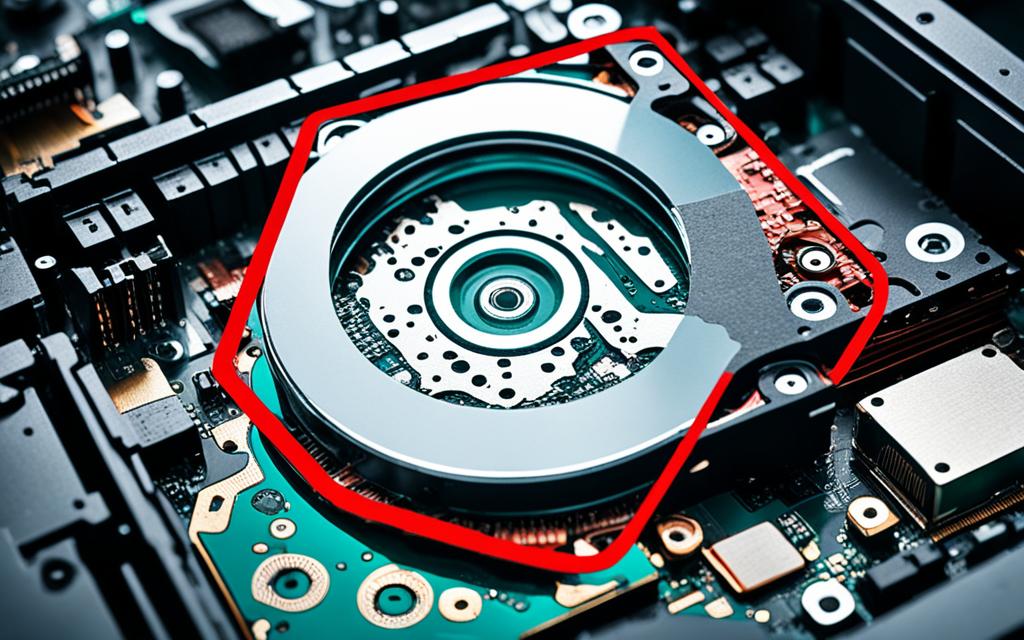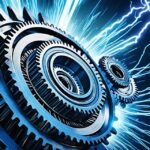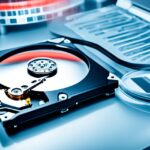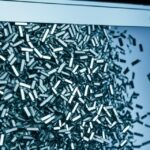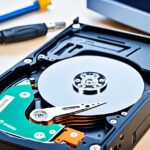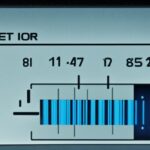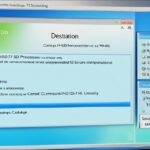Table of Contents
It’s very important to scan your hard drive (HDD) for bad sectors to keep your data safe. Bad sectors are damaged parts of the disk that can’t store data properly. This can really risk your information. Physical bad sectors are permanently damaged, while logical ones can act faulty. Spotting and dealing with these quickly helps prevent losing your data1.
This guide will show you how to check hard drives for bad spots and keep them healthy. You’ll understand why it’s key to scan regularly and what could go wrong if you don’t. Tools like the Windows Error Checking Utility and MiniTool ShadowMaker are great help23.
By keeping an eye on your HDD’s health and tackling bad sectors fast, you’ll keep your data safe. Let’s look at ways to keep your hard drive working well for longer.
Key Takeaways
- Understanding the distinction between physical and logical bad sectors is essential for HDD maintenance.
- Regular scans can protect against data loss and improve HDD health.
- Windows Error Checking Utility is a valuable tool for identifying and managing bad sectors.
- Advanced utilities like MiniTool ShadowMaker can facilitate backups and data integrity protection.
- Monitoring your hard drive’s performance can help you catch issues like excessive bad surname early.
- Prompt action in dealing with bad sectors can prevent complete hard drive failure.
Understanding Bad Sectors on Hard Drives
Bad sectors on hard drives are issues that impact how data is stored. It’s crucial to know about this to keep your HDD healthy. There are physical and logical bad sectors. Physical ones come from hard drive damage due to errors in making it or if it gets dropped3. Logical bad sectors happen because of software errors, like losing power while saving data or viruses4.
Definition of Bad Sectors
Physical bad sectors are damaged parts of the drive that can’t be used3. Logical bad sectors are clusters that don’t work right because of software problems. Knowing these helps spot hard drive issues early, as they might corrupt data4. Signs include weird noises or blue screen errors if problems get worse3.
Causes of Bad Sectors
Bad sectors can happen for many reasons. Not turning off your computer properly can cause logical bad sectors4. Dust and dropping the drive can create physical ones3. Although a few bad sectors aren’t a big worry, many could mean the drive might soon fail4. Regular cleaning and backups are important to avoid HDD problems2.
| Type of Bad Sector | Cause | Symptoms |
|---|---|---|
| Physical Bad Sectors | Damage from manufacturing defects or physical impact | Strange noises, inability to read/write data |
| Logical Bad Sectors | Software issues like sudden power loss or malware | Data corruption, errors during file access |
How to Scan HDD for Bad Sectors
Learning how to scan your HDD for bad sectors can boost your hard drive’s lifespan. We will look at two main methods for Windows: using the Windows Error Checking utility and the command prompt. Each method is key to keep your hard disk in top shape.
Using Windows Error Checking Utility
The Windows Error Checking utility makes finding drive issues easy. First, go to ‘My Computer’, right-click the hard disk to check, and click ‘Properties’. Next, hit the ‘Tools’ tab, then click ‘Check Now’. You’ll see options for automatic fixes, letting the tool correct problems on its own. This straightforward approach helps catch bad sectors early, preventing bigger headaches later on.
Using Command Prompt for Scanning
Using the command prompt for a HDD scan is another strong method. Open command prompt with admin rights and type chkdsk /f plus your drive’s letter. This checks the disk, fixing or marking bad sectors as not usable. If your drive is busy, you might need to run the scan after a reboot. It’s especially good for those who prefer using the command-line and ensures your drive stays healthy.
Scanning your hard drive often is vital to avoid data loss and hardware issues. For advice on checking your PC’s specifics, see: how to check computer specs5.
Methods to Repair Bad Sectors
When your computer finds bad sectors, fixing them quickly is key. There are two main ways: SeaTools diagnostics and a surface test. These help keep your hard drive healthy.
Using SeaTools Diagnostics
SeaTools is great for checking hard drives, especially Seagate and Maxtor ones. It runs thorough tests that find and fix bad sectors well. Along with SeaTools, AOMEI Partition Assistant greatly helps in fixing drive problems effectively6. If your drive has physical damage, like scratches, this tool is vital5.
Performing a Surface Test
A surface test checks your hard drive’s condition and highlights trouble spots. It spots easily fixable soft bad sectors by filling them with zeros using certain software5. If your programs run slowly or your drive makes odd noises, it’s time to check for bad sectors5. Doing these tests and using SeaTools regularly can help you fix bad sectors and protect your data.
Maintaining Your Hard Drive’s Health
Taking proactive steps is key to making hard drives last longer. It’s vital to perform regular scans to keep hard drives running well and to avoid sudden failures. Set up a regular scanning routine, especially if you notice anything strange with how the drive works.
Regular Scanning Recommendations
Scanning your hard drive often is really helpful. With Windows’ CHKDSK feature, you can easily find and fix problems. Using special programs gives even better results by showing more about the drive’s health7. These checks help avoid issues like bad sectors, which can lessen storage and make replacements necessary sooner8.
Data Backup Strategies
Having good backup plans is crucial for looking after your hard drive. Backing up data often keeps it safe, which is reassuring. is great for emergencies and protects against things like theft or fire. This can be safer than using physical storage9. Setting up automatic backups means you’re always protected. This service usually costs £5-£6 a month9.
Focus on these steps to keep your data safe and make your devices last longer.
Conclusion
Regular HDD scanning is crucial to keep data safe and hard drives reliable. By spotting signs like freezing, Blue Screen of Death, and system errors early, users can avoid data loss. Windows tools and other software help users check hard drives and follow good maintenance habits1011.
Backups are essential for data protection. They let users quickly recover important info if lost. Using SMART technology helps monitor hard drive health. This can stop problems before they worsen. A routine of scanning, upkeep, and backups ensures a safe digital space12.
It’s up to every user to protect their data by using these steps. Adding these habits to your tech care routine improves device use and secures your data. Investing in your hard drive’s care promises long-term reliability and peace of mind.
FAQ
What are bad sectors on a hard drive?
Bad sectors are damaged parts of a hard drive that struggle with reading or writing data. There are two kinds: physical, which are harmed by actual damage, and logical, which software problems cause.
How can I scan my HDD for bad sectors?
To scan your HDD, try the Windows Error Checking tool or Command Prompt. Right-click on the hard disk in ‘My Computer’, choose ‘Properties’, then ‘Tools’, and hit ‘Check Now’. Or, in Command Prompt, type ‘chkdsk /f’ to examine your drive’s condition.
What are the common causes of bad sectors?
Bad sectors often come from not shutting down properly, dust buildup, aging, or viruses. These issues can lower hard drive performance and reliability.
How can I repair bad sectors once they’ve been detected?
To fix bad sectors, use SeaTools Diagnostics for Seagate and Maxtor drives. It helps find and solve bad sector problems. Doing a surface test can show you where the problems are, which helps in fixing them or moving data safely.
How often should I scan my hard drive?
Scan your hard drive often, especially if you notice anything weird. Making a routine for these checks helps keep your HDD in good shape and stops big problems.
What data backup strategies should I consider?
For backing up data, consider external drives, cloud services, or backup software. Regular backups keep your files safe if your hard drive crashes.
Why is regular scanning important?
Regular scans keep your data safe and your hard drive working well. Knowing about HDD issues early on lets you take steps to avoid bigger problems later.
Source Links
- https://www.minitool.com/backup-tips/bad-sectors-on-hard-drive.html – What to Do If I Find Bad Sectors on Hard Drive in Windows 10/8/7? – MiniTool
- https://www.avast.com/c-chkdsk-windows – How to Use CHKDSK to Repair & Fix Windows Hard Drives
- https://www.diskpart.com/articles/test-bad-sectors-hard-drive-3690.html – How to Test Bad Sectors on Hard Drive or SSD [3 Methods]
- https://www.howtogeek.com/173463/bad-sectors-explained-why-hard-drives-get-bad-sectors-and-what-you-can-do-about-it/ – Bad Sectors Explained: Why Hard Drives Get Bad Sectors and What You Can Do About It
- https://www.diskgenius.com/how-to/bad-sector-repair-software.php – How to Check and Repair Bad Sectors for Hard Drives or USB Drives?
- https://www.diskpart.com/articles/how-to-remove-bad-sectors-from-hard-disk-permanently-1881.html – How to Remove Bad Sectors from Hard Disk Permanently
- https://www.pcmag.com/how-to/check-your-hard-drives-health – How to Check Your Hard Drive’s Health
- https://www.itamg.com/data-storage/hard-drive/health-check/ – How to Test Your Hard Drive Health: Windows, Mac OS, Linux
- https://www.easeus.com/partition-master/check-disk-errors-in-windows-10.html – How to Check and Scan Hard Drive for Errors Windows 11
- https://recoverit.wondershare.com/harddrive-recovery/check-hard-drive-for-bad-sectors.html – How To Check for Bad Sectors on a Hard Drive [3 Ways]
- https://www.arysontechnologies.com/blog/hard-disk-bad-sector-common-causes-and-solutions/ – Bad Sector in Hard Disk – Common Causes and Know Solution to Fix It
- https://superuser.com/questions/1803850/if-a-hard-drive-has-sectors-that-are-corrupt-or-physically-damaged-can-those-se – If a hard drive has sectors that are corrupt or physically damaged, can those sectors be written over?

